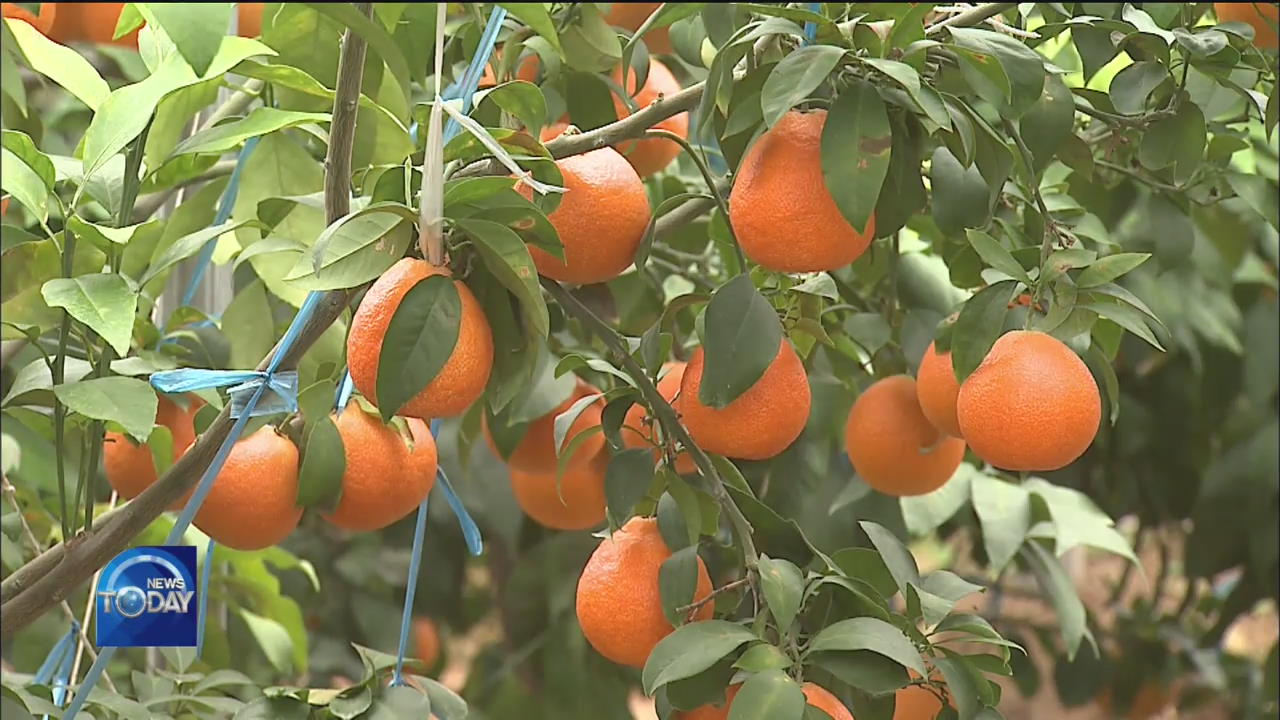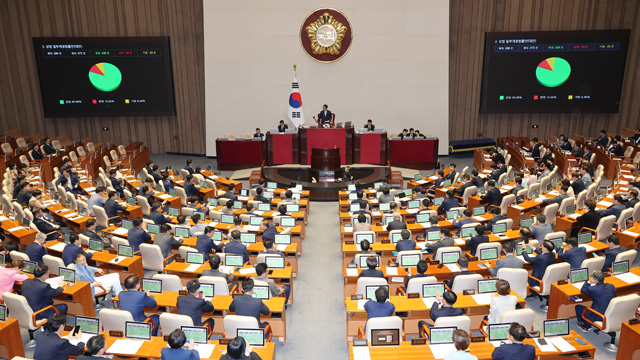EXPANSION OF TROPICAL FRUIT FARMING
입력 2019.10.14 (15:20)
수정 2019.10.14 (16:45)
읽어주기 기능은 크롬기반의
브라우저에서만 사용하실 수 있습니다.
[Anchor Lead]
As the climate of Korea is becoming more subtropical, tropical fruits are being grown even in the nation's central and northern regions. Some farms in Chungcheongnam-do Province, located in the central part of the country, have succeeded in cultivating a variety of tangerine, which used to be produced only in the southern parts of Jeju-do island. The success in this new cultivation method also means that farmers have secured a new source of income. Here's more
[Pkg]
Ipjang-myeon in Cheonan, Chungcheongnam-do Province is known as a major producer of grapes. However, branches of trees in this greenhouse are heavy with orange-colored fruits instead. These golden beauties are called hwanggeumhyang, a unique variety of tangerine produced in Jeju-do Island. Park Young-hwan has been a grape farmer for 30 years. But three years ago, he began growing tangerines. It was an easy choice, as growing tangerines requires only a tenth of the number of workers employed for grapes and the profit per 3.3 square meters of farmland is doubled.
[Soundbite] PARK YOUNGHWAN(HWANGGEUMHYANG FARMER) : "I learned from Jeju farms about how to prevent harmful insects and blight. After having mastered the method in three years, I can now harvest hwanggeumhyang like this."
Climate conditions in Cheonan are ideal for producing quality hwanggeumhyang, as it has 30 more sunny days than Jeju, annually, with a steep daily temperature gap in autumn. This farm alone is expected to harvest three tons of hwanggeumhyang this year.
[Soundbite] KIM JONG-MI(HWANGGEUMHYANG FARMER) : "It is new and thrilling to farm and produce tangerines here."
In all aspects including color, size and quality, they are comparable to Jeju hwanggeumhyang.
[Soundbite] YOON JI-WON(CHUNGNAM CHEONAN AGRICULTURAL TECHNOLOGY CENTER) : "The sugar content rises when the daily temperature gap is wide. Farmers say that Cheonan hwanggeumhyang has good color, as well as level of sweetness and acidity due to the wider temperature gap than Jeju."
As the temperature on the Korean Peninsula rises, the size of farmland for growing subtropical fruits continues to expand, in all regions excluding Jeju. In those areas, the size of such farmland more than tripled over the past eight years from 60,000 square meters in 2010 to 200,000 square meters last year.
As the climate of Korea is becoming more subtropical, tropical fruits are being grown even in the nation's central and northern regions. Some farms in Chungcheongnam-do Province, located in the central part of the country, have succeeded in cultivating a variety of tangerine, which used to be produced only in the southern parts of Jeju-do island. The success in this new cultivation method also means that farmers have secured a new source of income. Here's more
[Pkg]
Ipjang-myeon in Cheonan, Chungcheongnam-do Province is known as a major producer of grapes. However, branches of trees in this greenhouse are heavy with orange-colored fruits instead. These golden beauties are called hwanggeumhyang, a unique variety of tangerine produced in Jeju-do Island. Park Young-hwan has been a grape farmer for 30 years. But three years ago, he began growing tangerines. It was an easy choice, as growing tangerines requires only a tenth of the number of workers employed for grapes and the profit per 3.3 square meters of farmland is doubled.
[Soundbite] PARK YOUNGHWAN(HWANGGEUMHYANG FARMER) : "I learned from Jeju farms about how to prevent harmful insects and blight. After having mastered the method in three years, I can now harvest hwanggeumhyang like this."
Climate conditions in Cheonan are ideal for producing quality hwanggeumhyang, as it has 30 more sunny days than Jeju, annually, with a steep daily temperature gap in autumn. This farm alone is expected to harvest three tons of hwanggeumhyang this year.
[Soundbite] KIM JONG-MI(HWANGGEUMHYANG FARMER) : "It is new and thrilling to farm and produce tangerines here."
In all aspects including color, size and quality, they are comparable to Jeju hwanggeumhyang.
[Soundbite] YOON JI-WON(CHUNGNAM CHEONAN AGRICULTURAL TECHNOLOGY CENTER) : "The sugar content rises when the daily temperature gap is wide. Farmers say that Cheonan hwanggeumhyang has good color, as well as level of sweetness and acidity due to the wider temperature gap than Jeju."
As the temperature on the Korean Peninsula rises, the size of farmland for growing subtropical fruits continues to expand, in all regions excluding Jeju. In those areas, the size of such farmland more than tripled over the past eight years from 60,000 square meters in 2010 to 200,000 square meters last year.
■ 제보하기
▷ 카카오톡 : 'KBS제보' 검색, 채널 추가
▷ 전화 : 02-781-1234, 4444
▷ 이메일 : kbs1234@kbs.co.kr
▷ 유튜브, 네이버, 카카오에서도 KBS뉴스를 구독해주세요!
- EXPANSION OF TROPICAL FRUIT FARMING
-
- 입력 2019-10-14 15:21:16
- 수정2019-10-14 16:45:11

[Anchor Lead]
As the climate of Korea is becoming more subtropical, tropical fruits are being grown even in the nation's central and northern regions. Some farms in Chungcheongnam-do Province, located in the central part of the country, have succeeded in cultivating a variety of tangerine, which used to be produced only in the southern parts of Jeju-do island. The success in this new cultivation method also means that farmers have secured a new source of income. Here's more
[Pkg]
Ipjang-myeon in Cheonan, Chungcheongnam-do Province is known as a major producer of grapes. However, branches of trees in this greenhouse are heavy with orange-colored fruits instead. These golden beauties are called hwanggeumhyang, a unique variety of tangerine produced in Jeju-do Island. Park Young-hwan has been a grape farmer for 30 years. But three years ago, he began growing tangerines. It was an easy choice, as growing tangerines requires only a tenth of the number of workers employed for grapes and the profit per 3.3 square meters of farmland is doubled.
[Soundbite] PARK YOUNGHWAN(HWANGGEUMHYANG FARMER) : "I learned from Jeju farms about how to prevent harmful insects and blight. After having mastered the method in three years, I can now harvest hwanggeumhyang like this."
Climate conditions in Cheonan are ideal for producing quality hwanggeumhyang, as it has 30 more sunny days than Jeju, annually, with a steep daily temperature gap in autumn. This farm alone is expected to harvest three tons of hwanggeumhyang this year.
[Soundbite] KIM JONG-MI(HWANGGEUMHYANG FARMER) : "It is new and thrilling to farm and produce tangerines here."
In all aspects including color, size and quality, they are comparable to Jeju hwanggeumhyang.
[Soundbite] YOON JI-WON(CHUNGNAM CHEONAN AGRICULTURAL TECHNOLOGY CENTER) : "The sugar content rises when the daily temperature gap is wide. Farmers say that Cheonan hwanggeumhyang has good color, as well as level of sweetness and acidity due to the wider temperature gap than Jeju."
As the temperature on the Korean Peninsula rises, the size of farmland for growing subtropical fruits continues to expand, in all regions excluding Jeju. In those areas, the size of such farmland more than tripled over the past eight years from 60,000 square meters in 2010 to 200,000 square meters last year.
As the climate of Korea is becoming more subtropical, tropical fruits are being grown even in the nation's central and northern regions. Some farms in Chungcheongnam-do Province, located in the central part of the country, have succeeded in cultivating a variety of tangerine, which used to be produced only in the southern parts of Jeju-do island. The success in this new cultivation method also means that farmers have secured a new source of income. Here's more
[Pkg]
Ipjang-myeon in Cheonan, Chungcheongnam-do Province is known as a major producer of grapes. However, branches of trees in this greenhouse are heavy with orange-colored fruits instead. These golden beauties are called hwanggeumhyang, a unique variety of tangerine produced in Jeju-do Island. Park Young-hwan has been a grape farmer for 30 years. But three years ago, he began growing tangerines. It was an easy choice, as growing tangerines requires only a tenth of the number of workers employed for grapes and the profit per 3.3 square meters of farmland is doubled.
[Soundbite] PARK YOUNGHWAN(HWANGGEUMHYANG FARMER) : "I learned from Jeju farms about how to prevent harmful insects and blight. After having mastered the method in three years, I can now harvest hwanggeumhyang like this."
Climate conditions in Cheonan are ideal for producing quality hwanggeumhyang, as it has 30 more sunny days than Jeju, annually, with a steep daily temperature gap in autumn. This farm alone is expected to harvest three tons of hwanggeumhyang this year.
[Soundbite] KIM JONG-MI(HWANGGEUMHYANG FARMER) : "It is new and thrilling to farm and produce tangerines here."
In all aspects including color, size and quality, they are comparable to Jeju hwanggeumhyang.
[Soundbite] YOON JI-WON(CHUNGNAM CHEONAN AGRICULTURAL TECHNOLOGY CENTER) : "The sugar content rises when the daily temperature gap is wide. Farmers say that Cheonan hwanggeumhyang has good color, as well as level of sweetness and acidity due to the wider temperature gap than Jeju."
As the temperature on the Korean Peninsula rises, the size of farmland for growing subtropical fruits continues to expand, in all regions excluding Jeju. In those areas, the size of such farmland more than tripled over the past eight years from 60,000 square meters in 2010 to 200,000 square meters last year.
이 기사가 좋으셨다면
-
좋아요
0
-
응원해요
0
-
후속 원해요
0












![[단독] 김민석 총리, 취임 첫 일정으로 ‘송미령 반대’ <br>농민단체 농성장 방문](/data/news/2025/07/03/20250703_YUTdgQ.png)




이 기사에 대한 의견을 남겨주세요.